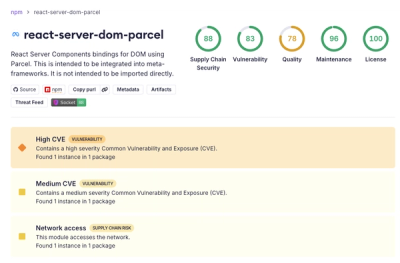
Security News
Deno 2.6 + Socket: Supply Chain Defense In Your CLI
Deno 2.6 introduces deno audit with a new --socket flag that plugs directly into Socket to bring supply chain security checks into the Deno CLI.
Installs a node binary into your project, which because npm runs scripts with the local ./node_modules/.bin in the PATH ahead of the system copy means you can have a local version of node that is different than your system's, and manage node as a normal dependency.
Warning: don't install this globally with npm 2. npm@2 immediately removes node, then can't run the scripts that make this work.
npm i node@lts
npxnpx node@4 myscript.js
This will run myscript.js with the latest version of node from the v4 major.
Using the shell auto-fallback of npx, you can even do it like so:
node@4 myscript.js
Major thanks to Kat Marchán for late-night problem solving, and to CJ Silverio and Maciej Małecki for egging me on way back when I had the idea to package node up this way. It does turn out if you ask "why not?!" once in a while something fun happens.
FAQs
node
The npm package node receives a total of 404,009 weekly downloads. As such, node popularity was classified as popular.
We found that node demonstrated a healthy version release cadence and project activity because the last version was released less than a year ago. It has 1 open source maintainer collaborating on the project.
Did you know?

Socket for GitHub automatically highlights issues in each pull request and monitors the health of all your open source dependencies. Discover the contents of your packages and block harmful activity before you install or update your dependencies.

Security News
Deno 2.6 introduces deno audit with a new --socket flag that plugs directly into Socket to bring supply chain security checks into the Deno CLI.

Security News
New DoS and source code exposure bugs in React Server Components and Next.js: what’s affected and how to update safely.

Security News
Socket CEO Feross Aboukhadijeh joins Software Engineering Daily to discuss modern software supply chain attacks and rising AI-driven security risks.